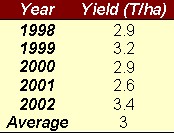
The aim of this section of the investigation is to quantify the amount of biodiesel that could be produced from the available land within the UK as worked out in the previous section.
Similar to bioethanol it is first necessary to assess the potential yields of the most suitable crops.
The main energy crop which would be grown in the United Kingdom to produce biodiesel would be Oilseed Rape. Other potential crops would include sunflowers, linseed and castor, however Oilseed rape is by far the most suitable for UK agriculture.
 |
The Table to the right shows the average annual rapeseed yields since 1998 (ref17), the average yield over this time is 3 tonnes per hectare. For the purpose of this investigation this value shall be used to calculate how much biodiesel can be produced from rapeseed.
Assuming that all of the 644,000 hectares of UK setaside land is used to produce biodiesel from rapeseed then:
Rapeseed Yield = 644,000 * 3 = 1,932,000 Tonnes per year
We know from the what is biodiesel section that the production process for biodiesel requires the vegetable oil to be extracted from the seed. This can be done simply by crushing the seed and extracting the oil or by solvent extraction. Either way there is generally a 40% oil content available by mass within the seed.
Therefore:
Oil Yield = 0.4 * 1,932,000 = 772,800 Tonnes per year
Again refering to the what is biodiesel section we know that there is around a 97% conversion from the raw vegetable oil to the biodiesel during the transesterification process.
Therefore:
Biodiesel Yield = 0.97 * 772,800 = 749,616 Tonnes per year or 851,836,000 litres per year
The total biodiesel production assuming use of 100% of the set aside land would be 851,836,000 Litres. For simplicity this can be rounded to 0.85 billion litres.
In 2002 the UK released for consumption 19.764 billion litres of diesel (ref18). By volume, the biodiesel produced from the set aside land could displace 4.3% of this diesel. This figure however is inaccurate unless the energy content of the fuel is taken into account.
Similar to bioethanol, biodiesel has a lower energy content than its equivalent traditional fuel, however in the case of biodiesel and diesel the difference is not as great. Diesel has an energy content by volume of around 37.9 MJ/L. Biodiesel has an energy content by volume of around 35.6 MJ/L.
The total energy contained in 19.764 Billion litres of diesel:
= 19.764 billion * 37.9 = 749 billon MJ
The total energy contained in 0.85 billion litres of biodiesel:
= 0.85 billion * 35.6 = 30.3 billion MJ
This means that using all the setaside land to produce biodiesel could displace 30.3 billion MJ of the energy contained within the petrol, this is a 4% displacement by energy. 30.3 billion MJ of energy equates to 0.8 billion litres of diesel. Therefore 0.8 billion litres is the volume of diesel that would be saved over the year using all the setaside land.
Using all the set aside land to produce Biodiesel would result in:
If, for example, a 2% displacement by volume was required then we wouild require:
Just like the bioethanol production there are many assumptions and limitations that should be taken into account. The problem of monoculture is discussed in the Bioethanol Limitations and Assumptions section and this is applicable to oilseed rape also. For reasons of monoculture it is unlikely that rapeseed would be grown on 100% of the setaside land, however if it was grown with wheat and sugar beet as discussed in the previous section then the crops could possibly be successfully rotated. This however is a big assumption and would require trials to assess its feasibility.